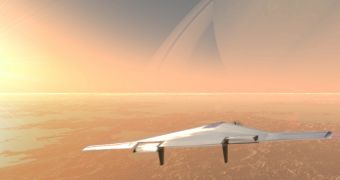Engineers with defense and aerospace contractor Northrop Grumman and Tustin, California-based smart space technology company L'Garde announce the development of a new concept airplane, which could fly in the skies above Venus for up to a year. Such an asset could reveal a multitude of new data about our neighboring world, which features temperatures significantly higher than those on Earth.
The innovative idea calls for the construction of a big robotic airship called the Venus Atmospheric Maneuverable Platform (VAMP), which could remain aloft as long as 12 months by making use of a special combination of powered propulsion, gliding and floating.
The best thing about this idea, the team argues, is that no additional technological breakthrough are needed to make it happen. In other words, if the funds required to assemble a mission are provided, a demonstrator could launch within a couple of years. At this point, VAMP is in the design phase.
Though it boasts a wingspan of 46 meters (151-foot), which puts that of the space shuttles to shame, the inflatable aircraft is unbelievably light, weighing just 450 kilograms (992 pounds). For comparison, an orbiter tips the scale at around 2,030 tons (4,470,000 pounds).
The aircraft features a triangular design, which would allow it to cut through the hellishly-hot Venusian atmosphere with ease, while also allowing it to dissipate heat effectively. Engineers at Northrop and L'Garde plan to deploy it via a carrier spacecraft. VAMP would then be filled with hydrogen or other types of buoyant gases, before being lowered into the upper atmosphere.
Shortly before entering the atmosphere, the aircraft would detach from its carrier, and hit the upper layers of Venusian air at a very slow speed. This would have the added benefit of eliminating the need for costly and heavy thermal-protection gear, such as the ceramic tiles on the space shuttles.
Mission planners envision scenarios where the VAMP would cruise high above the surface of Venus, at altitudes ranging from 55 to 70 kilometers (34 to 43 miles), conducting observations of both the planet's surface and its air. The higher altitudes would be reached via powered flight during the day.
During the night, the aircraft would glide atop the hotter layers of the lower Venusian atmosphere, not consuming any power. Solar panels would be attached to the propellers for providing daytime power and for recharging the batteries that may be needed during the night.
Another solution is using an advanced stirling radioisotope generator (ASRG) that uses the decay of plutonium-238 isotopes for electricity production, Space reports. In order to reach altitudes of 70 kilometers, VAMP would have to carry no more than 20 kilograms (44 pounds) of scientific equipment.
By lowering the maximum altitude to just 68 kilometers (41 to 42 miles), the total weight of the science payload could be increased to 200 kilograms (440 pounds). This would enable the integration of a low-power communications suite, capable of relaying data to Earth via the carrier spacecraft in orbit.
Officials at Northrop say that it is entirely possible to envision VAMP-like vehicles delivering rovers or landers on the surface of other worlds. Furthermore, this design could be employed to conduct low-altitude reconnaissance flights over the surface of Saturn's largest and most interesting moon, Titan.

 14 DAY TRIAL //
14 DAY TRIAL //